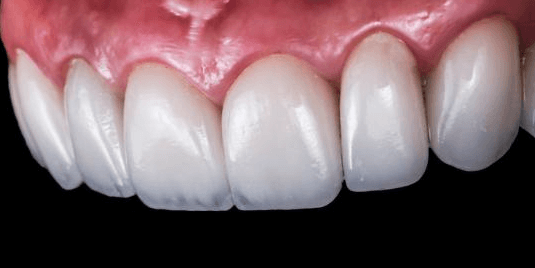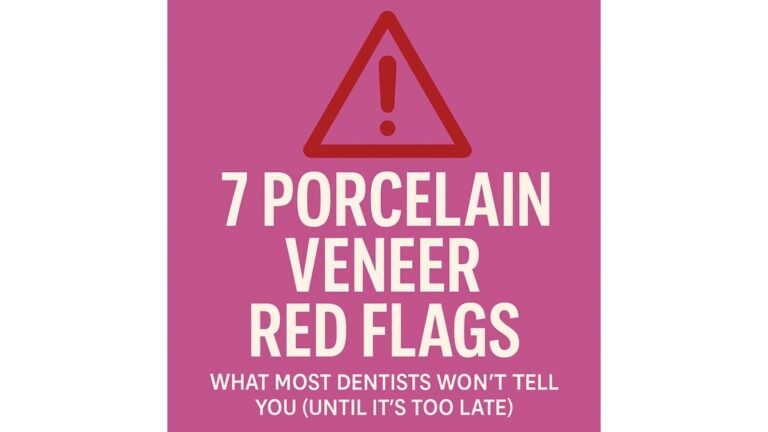Porcelain Veneers Toothpaste Warning: Why RDA Matters More Than You Think
If you have porcelain veneers, traditional composite bonding, or enhanced composite resin veneers, your toothpaste could be slowly wearing away your results.
The issue is RDA or Relative Dentin Abrasivity which measures how abrasive a toothpaste is.
Higher RDA means more wear on both natural teeth and cosmetic restorations. Over time, even high-end dental work can become dull, scratched, or stained just from brushing with the wrong product.

What’s a Safe RDA Score?
| RDA Range | Abrasivity Classification | Toothpastes (with Verified RDA Scores) |
|---|---|---|
| 0–30 | Very Low — ideal for veneers and bonding | Plain water (4), Baking soda (7–8), Biotène Dry Mouth (~25), Elmex Sensitive Plus (~26–30) |
| 31–70 | Low — safe for veneers and bonding | Sensodyne Pronamel (~34), Tom’s Sensitive (~45–50), Colgate Cavity Protection (~68), Clinpro 5000 (~68) |
| 71–100 | Moderate — occasional use if needed | Colgate Total (70–100), PreviDent 5000 Enamel (~40–80), Colgate Optic White (~100) |
| 101–150 | High — avoid with any dental work | Crest Pro-Health (~130) |
| 151–250+ | Very High — damaging to natural enamel | Crest 3D White (Vivid) (~200), Ultra Brite Advanced Whitening (~260) |
RDA scores are based on standardized lab tests and provide a general sense of toothpaste abrasiveness. They can vary by formulation, lab conditions, or manufacturer data.
✅ Low-Abrasive Toothpastes (Safe for Porcelain Veneers, Composite Bonding, and Resin Veneers)
These toothpastes are gentle enough for porcelain veneers, composite bonding, and resin veneers. They help preserve the glaze and polish of your dental work while minimizing surface wear.
If you’ve invested in cosmetic dentistry, sticking to low-abrasive options like these is essential for long-term result.
RDA scores can vary depending on the testing source or method. These numbers are approximate and meant for general guidance only. Always consult with your dentist for personalized recommendations.
| Toothpaste | RDA | Source |
| Plain water (no toothpaste) | 4 | Lab standard |
| Baking soda (sodium bicarbonate) | 7–8 | Independent test |
| Biotène Genlte Forumla Toothpaste | ~62.15 – Manually verified | Manufacturer/compiled data |
| Elmex Sensitive Plus | ~26 | Hamza et al. (2020) |
| Sensodyne Pronamel | ~34 | Independent/ISO test |
| Tom’s of Maine Sensitive | ~49 | Compiled data (independent) |
| Colgate Cavity Protection | ~68 | Independent/ADA data |
| Clinpro 5000 (3M ESPE) | ~62.15 – Manually verified | Independent (3M/University study) |
“Manually verified” means the RDA score was confirmed through direct contact with the manufacturer or found in official manufacturer literature or published studies
BBV First Choice: Biotene Gentle Formula Fluoride Toothpaste

Description: Ultra gentle and designed specifically for dry mouth, Biotene is a trusted choice for people with veneers, bonding, or sensitivity.
Its low-abrasive formula cleans without irritation and helps maintain moisture in the mouth, making it ideal for those with delicate dental work.
RDA Score: 62.15 ( low and enamel safe)
Free of: SLS (sodium lauryl sulfate), alcohol, and strong detergents
Mild flavor: Designed for dry, sensitive mouths
Xylitol free: Suitable for those avoiding sugar alcohols
Fluoride included: Helps protect natural teeth and restorations
Price: Typically $8 to $11 per tube, often lower when purchased in multi-packs
Why This Toothpaste Is Popular in Our Community
People with porcelain veneers or composite bonding often experience dry or sensitive mouths, which can make everyday brushing uncomfortable.
That’s why many in our community choose Biotene. It has a nonabrasive, SLS-free formula that helps maintain moisture without irritating dental work.
With added fluoride and no harsh ingredients, it offers a gentle and effective way to support long-term oral health and comfort
Disclaimer: This toothpaste contains fluoride. While fluoride is widely used to strengthen enamel and prevent cavities, some individuals prefer fluoride-free options. Always consult your dentist to determine what is best for your individual needs.
⚠️ Moderate Abrasive Toothpastes (Use Occasionally)
These toothpastes fall into a gray area. While they may be safe for natural teeth, they can gradually dull or scratch veneers and bonding if used regularly. If you choose to use a moderate-abrasive toothpaste, do so sparingly and monitor your results closely.
| Toothpaste | RDA | Source |
| Colgate Total (Original) | 70–100 | Independent (2015 & 2019) |
| PreviDent 5000 Enamel | ~40–80 | Manufacturer tech sheet |
❌ High-Abrasive Toothpastes (Avoid with Veneers or Bonding)
High-abrasive toothpastes pose a serious risk to cosmetic dental work. They can strip the glaze from porcelain veneers, scratch composite surfaces, and leave resin restorations looking dull or worn.
These products are best avoided entirely if you want to maintain the integrity and appearance of your smile
| Toothpaste | RDA | Source |
| Crest Pro-Health | ~130 | Independent/compiled data |
| Colgate Optic White | ~100 | Manufacturer data |
| Crest 3D White (Vivid/Whitening) | ~200 | Independent/compiled data |
| Ultra Brite Advanced Whitening | ~260 | Independent/compiled data |
Toothpastes Without Verified RDA Data (Use With Caution)
Some toothpastes do not appear in peer-reviewed studies or verified technical data sources, so we cannot confirm their RDA levels. As a result, they may not be safe for people with porcelain veneers, composite resin bonding/veneers, or enamel erosion.
We reached out to several manufacturers, but they could not provide supporting data. Many of the lists circulating online are based on dentists’ blogs or outdated charts that lack references, studies, or independent lab verification. We don’t feel comfortable listing these toothpastes without concrete data and transparency. If you have verified data, please email us, and we will update the chart accordingly.
| Toothpaste | Status |
|---|---|
| Close-Up | No verified RDA data |
| Crest 3D White Glamorous White | No verified RDA data |
| PreviDent 5000 Enamel Protect | No verified RDA data |
| Colgate Total Deep Clean | No verified RDA data |
| Crest Pro-Health Smooth Formula | No verified RDA data |
| Colgate Tartar Control | No verified RDA data |
| Colgate Sensitive Enamel Protect | No verified RDA data |
| Jason Powersmile | No verified RDA data |
| Colgate Total (2020 formula) | No verified RDA data |
| Crest Gum Detoxify | No verified RDA data |
| Sensodyne Repair and Protect | No verified RDA data |
| Crest Regular | No verified RDA data |
| Pepsodent | No verified RDA data |
| CloSYS Fluoride Toothpaste | No verified RDA data |
| Marvis Whitening Mint | No verified RDA data |
| Arm & Hammer Peroxicare | No verified RDA data |
| Tom’s of Maine Whole Care | No verified RDA data |
| Squigle Enamel Saver | No verified RDA data |
| Crest Pro-Health (original) | No verified RDA data |
| Aqua Fresh Whitening | No verified RDA data |
| Hello Sensitivity Relief | No verified RDA data |
Why It Matters
- Porcelain veneers toothpaste should protect, not wear down the glaze
- Composite bonding toothpaste must be gentle to avoid surface scratches and early staining
- Resin veneers toothpaste should maintain polish and resist microdamage over time
Final Tips for Long-Term Results
- Use a soft-bristled toothbrush
- Avoid scrubbing back and forth
- Always check the RDA score of your toothpaste
- When in doubt, choose a product with an RDA under 70
When it comes to caring for porcelain veneers, composite bonding, or resin veneers, the toothpaste you choose matters more than most people realize.
RDA scores can make the difference between a long-lasting smile and one that becomes dull, scratched, or damaged over time.
By sticking with low-abrasive options and being mindful of your daily habits, you can protect your investment and keep your smile looking its best for years to come potentially extending its life well beyond the commonly cited 10 to 15 year range.

Disclaimer: This content is for informational purposes only and does not constitute medical or dental advice. Please consult a licensed dental professional before making any treatment decisions.
If you have questions about this article, need help understanding your options, or want to know what to ask during a consultation, we’re here to help. Just leave us a message — even a quick question like:
- “Do you know any qualified dentists who offer enhanced composite resin veneers?”
- “How do I know if this is right for me?”
- “What are the typical costs among providers for enhanced composite resin veneers?”
- “What should I ask my dentist before starting treatment?”
- “Is there a way to tell if my teeth are healthy enough for this type of veneer?”
- “What’s the difference between traditional bonding and enhanced composite resin?”
Every person’s case is unique, and while we’ll do our best to answer your questions and share helpful insights, always consult a licensed dental professional before making any treatment decisions.





